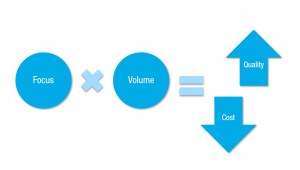
Value for money
Is this a threatening situation for medical specialists? The care consumer wants Value for Money. In other words, this could be defined as “when I undergo treatment, I want to see that it produces results.” An example of this is that health care consumer reports to a medical specialist with pain in the shoulder. In the past, treatments were carried out and few critical questions were asked about the effectiveness of the treatment. However, nowadays there are many more treatment types and the demands of the patient (health care consumer) have increased.
Role of the medical specialist
How does this affect the medical specialist’s role? The role changes from the traditional doctor-patient relationship to a more coaching role for the doctor. In this sense, the doctor is able to guide the patient in his/her recovery process. Moreover, the medical specialist has to learn to deal with the changing wishes and needs of his/her patients.
Treatment pathways based on data
Due to the influence of an aging world population and the increase in lifestyle-related diseases such as diabetes, obesity, and heart failure and the various comorbidities associated with them, the volume of care will increase in the coming years. Effective and efficient treatment methods are crucial in order to cope with the patient’s ever-increasing demand and requirements. In many countries, it has been calculated that the shortage of physiotherapists and medical specialists will drastically increase in the coming years. We simply cannot meet this demand without further rising healthcare costs. We will have to adopt other ways of working in order to be able to meet this changing demand. A good example of this is the use of advanced DAVID equipment for musculoskeletal disorders. The equipment and software have been developed in such a way that larger volumes of patients can be treated at the same time without compromising quality. The following volume is used:

Volume and quality
Can more volume, less staff, and quality go hand in hand? Through the use of advanced software, this does go together. A frequently heard feedback from the medical specialists who work with DAVID technology is that there is more time for health care consumer when working with our equipment. An example of this is the cooperation/triage of a pain doctor with a physiotherapist. When a health care consumer visits the pain center with persistent shoulder complaints, the health care consumer can visit the physiotherapist and the pain doctor on the same day. The pain doctor starts the pain treatment and the first visit is then scheduled with the physiotherapist. The physiotherapist makes an analysis of the shoulder using the David shoulder equipment and tests the mobility of the shoulder joint. Because of this accurate measurement, a specific treatment plan is drawn up and patients can receive a targeted training program. Questionnaires and outcome measurements are automated within the workflow and the training intensity is optimized on the basis of program rules. Within the training room, it is possible for a physiotherapist to treat 1 to 6 instead of 1 to 1.
At the end of the program, there is an outtake consultation with the pain physician who can evaluate all data together with the health care consumer in his coaching role.
The advantages of DAVID technology are:
- Multidisciplinary collaboration between the medical specialist and physiotherapist
- Centralization of care data within the EVE system
- Possibility to treat 1-6
- Deployment of workflows including testing and measuring, questionnaires, homework exercises, and program rules
- Evaluations based on objective data
Conclusion
Health care consumers become more critical and are more demanding of the treatment. The medical specialist’s role transforms into a coaching role and the patient becomes more responsible for his own rehabilitation process. Advanced technology enables medical specialists to manage their time more efficiently. Systematic collection of outcome data will become the norm and 1-1 treatment of patients is no longer tenable in the near future.

Information and contact
Would you like to know more about David technology or would you like help drawing up a business plan for your own center? Then please contact us.
 English
English 
























